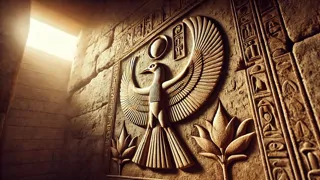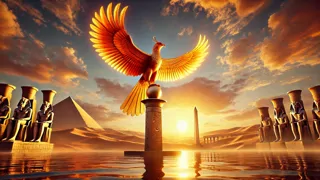Introduction
Half-forgotten by time, the legend of the Benu Bird rises each dawn from the eastern horizon, an emblem of transformation whose wings carry the promise of renewal. In ancient Egyptian temples carved of sandstone and shadow, priests kept vigil near the glittering Nile, listening for the soft rustle of feathered gold that stirred the air like the first breath of creation. This slender, powerful creature perched above the primordial waters, drawing sustenance from the cradle of existence and reflecting the heat of the sun in its brilliant plumage. Each cycle of the sun ignited its feathers, turning ordinary flame into a living spark that heralded a new beginning across desert and delta alike. At the hush before dawn, the Benu Bird’s piercing cry rang out like an invitation to witness life’s eternal dance—the fragile balance between endings and beginnings, between trials and triumphs. When the bird’s life reached its zenith, it embraced the Phoenix Fire, a crucible of golden flames so intense that its form dissolved into ember and ash. Yet from those glowing remains, a fresh brood emerged, their wings unfurling in a symphony of color and light. In this sacred cycle, Egypt’s forebears found solace; they saw that endings are not absolutes but thresholds, and that courage to burn away the old can open the way for something vibrant, new, and essential. Today, as the earth navigates uncertain climates and shifting tides, the tale of the Benu Bird speaks across centuries, reminding us that renewal often follows destruction and that mindful stewardship can spark the rebirth of ecosystems in need of care. In every ember lies the seed of renewal, and in every act of regeneration, the echoes of an ancient bird’s flight.
Origins of the Benu Bird
In the earliest chants of Egyptian priests, the Benu Bird appears as a creature born of the sun and the primeval waters. Scholars believe the myth took shape in Heliopolis, where the sun god Ra’s energy merged with the river’s life force. The Benu Bird was said to perch on the Weeping Willow of Creation, singing the new year into being as it gazed across the reflective floodplains. Over generations, artisans carved its likeness on temple walls—long neck arched in reverence, wings spread against a halo of light. In painted papyrus scrolls, the bird holds an ankh, symbolizing life renewed through fire and water.

Priests of Heliopolis interpreted the Benu’s cycle as a ritual of transformation. At dawn, they lit braziers in its honor and recited hymns that echoed down obelisk-lined courtyards. As breath turned to prayer, witnesses reported feeling a hush, as though the world paused to witness the dance between creation and destruction. Children, finger-painted with ochre and malachite, watched with eyes alight, while elders placed offerings of lotus blossoms and bread at the base of sanctuaries. Each gesture wove community and cosmos together, celebrating nature’s eternal cadence.
The Benu Bird’s name may derive from the Egyptian verb “bnw,” to rise or shine. It embodied both solar energy and the lifting of spirits in times of drought or hardship. Farmers, burning fields at year’s end to enrich the soil, saw in the charred stalks the promise that ash could give life again. This agricultural echo transformed the myth from legend to practical counsel—reminding people that cycles of fallow and fruitfulness mirrored the Benu’s own rebirth.
The Phoenix Fire and Rebirth
Central to the myth is the Phoenix Fire—a purification so fierce that all memory dissolves in its glow. The Benu Bird, upon reaching the peak of its lifespan, summoned this fire in a hidden grove shaded by tamarisk trees. According to account, its feathers blazed with hues of amber, crimson, and gold until they ignited. Witnesses described a pillar of flame that stretched toward the sky, returning in a cinder-laden breeze that whispered of endings and beginnings intertwined.

In some versions, the bird kindled the flames itself; in others, the sun god Ra descended to light it in a celestial gesture. As the fire raged, the Benu Bird’s form dissolved into a swirling dance of sparks, leaving behind only bones glowing white-hot. When at last the embers cooled, a single egg emerged—golden-hued and warm. Within it, the promise of renewal lay nestled. From this vessel came the next Benu, unbroken in lineage yet unique in feather pattern, a fresh guardian of balance.
The rebirth ritual spoke directly to cycles of flood and drought along the Nile. When waters rose, farmers rejoiced in new silt and abundant crops; when they receded too quickly, fear fell like darkness. The Phoenix Fire offered a parable: sometimes fields must burn to yield richer harvests. Temples celebrated with controlled blazes in amphitheaters, releasing plumes of smoke that carried incense and lotus petals. The sight and scent worked in concert, reminding people that sacrifice could spark regeneration.
As empires waned, emperors claimed descent from the Benu Bird, sealing their rule with motifs of white-gold plumage on thrones and crowns. Yet the truest lesson remained with the people in simple devotion: that fire, though consuming, also clears the way for growth.
Echoes of Renewal in Modern Times
Centuries later, the Benu Bird’s myth takes on new resonance as humanity confronts global warming, deforestation, and environmental upheaval. Conservationists draw inspiration from its cycle, advocating for controlled burns to restore prairies and forests in places like California and Australia. Ecologists note that certain ecosystems depend on fire to release seeds and maintain biodiversity—an echo of the Phoenix Fire’s creative force.

In Egypt, rising temperatures and shifting flood cycles challenge farmers who still honor the Benu’s legacy at planting season. Scientists working along the Nile collaborate with local communities to revive ancient water management systems—basins, canals, and raised fields that once formed a natural equilibrium. Workshops feature the Benu Bird as a cultural touchstone, framing modern solutions within a narrative of continuity rather than crisis.
Artists and poets around the world invoke the Benu Bird to explore themes of loss and regeneration. Murals depicting its flight over charred landscapes appear in cities grappling with climate disasters. In classrooms, children enact the myth with papier-mâché models, learning how ashes from controlled fires can enrich soil. Social media campaigns use animated renderings of the bird rising from smoldering embers, urging collective action to “ignite hope, not fear.”
This blending of ancient wisdom and contemporary science illustrates that the Benu Bird’s cycle extends beyond legend. Fire, often seen only as destruction, becomes a symbol of intentional renewal—reminding us that in every challenge lies the spark of possibility, and that working with nature’s rhythms can guide us toward a more balanced future.
Conclusion
The story of the Benu Bird and the Phoenix Fire has traveled across millennia, shaping rituals, art, and agriculture from ancient Egypt to the present day. It teaches that endings need not spell despair, but can usher in fresh cycles of growth when guided by wisdom and care. As modern societies face environmental crossroads, the Benu Bird reminds us that fire, though harsh, can be a tool for renewal and that ashes hold the seeds of tomorrow’s forest. Embracing this ancient parable, communities around the globe are harnessing controlled burns, restoring wetlands, and reviving sustainable practices—each effort a small reflection of the bird’s timeless cry at dawn. In honoring the Phoenix Fire, we learn to steward the earth’s rhythms and cultivate hope from the embers of our challenges.



















